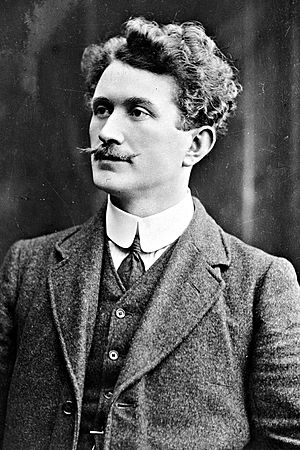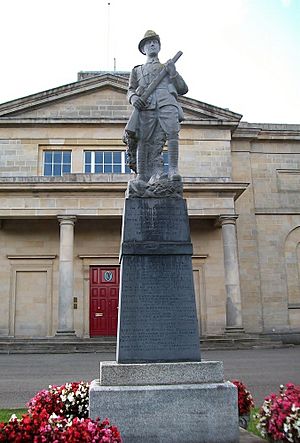Thomas Ashe facts for kids
Quick facts for kids
Thomas Ashe
|
|
|---|---|
 |
|
| President of the Irish Republican Brotherhood | |
| In office 1916 – September 1917 |
|
| Preceded by | Denis McCullough |
| Succeeded by | Seán McGarry |
| Personal details | |
| Born | 12 January 1885 Lispole, County Kerry, Ireland |
| Died | 25 September 1917 (aged 32) Dublin, Ireland |
| Military service | |
| Allegiance | Irish Republican Brotherhood Irish Volunteers |
| Years of service | 1913–1917 |
| Rank | Battalion Commander |
Thomas Patrick Ashe (Irish: Tomás Pádraig Ághas; 12 January 1885 – 25 September 1917) was an important Irish leader. He was a member of several groups that worked for Irish independence. These included the Gaelic League, which promoted the Irish language, and the Gaelic Athletic Association, which promoted Irish sports. He was also part of the Irish Republican Brotherhood (IRB) and helped start the Irish Volunteers.
Who Was Thomas Ashe?
Thomas Ashe was born in a place called Kinard East, near Lispole in County Kerry, Ireland. His family spoke both Irish and English at home. His father was very good at Irish, and people would come to listen to his stories.
Thomas became a teacher in 1908, working as a principal at Corduff National School in Lusk, County Dublin. He loved the Irish language and taught it at his school. He also helped start branches of the Gaelic League in nearby towns. He even encouraged his students to march over the British flag, the Union Jack, to show their Irish pride.
Before he died, Thomas taught children in Lusk. He also started a famous pipe band called the Lusk Black Raven Pipe Band. In 1906, he helped create the Round Towers Lusk Gaelic Athletic Association (GAA) Club.
Thomas joined the Irish Volunteers when it began in November 1913. This group was formed to protect Ireland's right to govern itself. He was a leader in the Lusk company of the Volunteers. In 1914, he traveled to the USA and collected a lot of money for both the Volunteers and the Gaelic League. He also supported workers during the 1913 Dublin Lockout, saying he was on the side of the workers' leader, Jim Larkin.
The Easter Rising
Thomas Ashe played a big part in the 1916 Easter Rising. This was a rebellion against British rule in Ireland. He was in charge of the Fingal battalion (5th battalion) of the Irish Volunteers. This group had about 60 to 70 men. They fought British forces in north County Dublin.
Ashe's battalion won an important battle in Ashbourne, County Meath. They fought a much larger British force and captured many weapons and vehicles. Eleven British police officers and two Irish Volunteers died in this battle. About 24 hours after the main rebellion in Dublin ended, Ashe's group surrendered. They followed orders from Patrick Pearse, another leader of the Rising.
After the Rising, Thomas Ashe and another leader, Éamon de Valera, were put on trial. They were sentenced to death, but their sentences were changed to life in prison. Ashe was held in prisons in England, including Frongoch internment camp and Lewes Prison. While in prison, he wrote a poem called "Let Me Carry Your Cross for Ireland, Lord."
In 1917, the British government was under pressure to deal with the "Irish problem." Thomas Ashe and other prisoners started a hunger strike to help this pressure. A hunger strike is when prisoners refuse to eat to protest. News of how the prisoners were being treated spread, and there were many protests in Ireland. Because of this, Ashe and the other prisoners were set free in June 1917.
His Final Protest and Death
After being released from prison, Thomas Ashe returned to Ireland. He started giving many speeches. In August 1917, he was arrested again for a speech he gave in Ballinalee, County Longford. He was taken to Mountjoy Prison in Dublin.
He was found guilty of speaking against the government and sentenced to two years of hard labor. Ashe and other prisoners, including Fionán Lynch and Austin Stack, demanded to be treated as "prisoners of war." This meant they wanted to be treated like soldiers captured in battle, not criminals.
To protest, Ashe started another hunger strike on September 20, 1917. The prison authorities took away the prisoners' beds, blankets, and boots. After several days of lying on a cold stone floor, the prisoners were fed against their will.
On September 25, Fionán Lynch saw Ashe being carried away for this treatment. He called out to Ashe, "Stick it Tom!" Ashe called back, "I'll stick it, Fin!" This was the last time they spoke. Ashe was carried back, looking blue and unconscious. He was taken to the Mater Misericordiae Hospital and died a few hours later.
An investigation into his death found that the prison staff had acted in an "inhuman and dangerous" way. They said Ashe died because he was fed against his will, and because his bed and boots had been taken away, which made him weak.
Thomas Ashe's death had a huge impact on the Irish people. It became a powerful reason for people to support the idea of an independent Irish Republic. His funeral was a very large event. Over 30,000 people marched to Glasnevin Cemetery. Michael Collins, another famous Irish leader, gave a speech at the funeral. He said, "That volley which we have just heard is the only speech which is proper to make above the grave of a dead Fenian." This showed that the Irish Volunteers were becoming strong again.
Thomas Ashe was related to the American actor Gregory Peck.
See also
- List of people on stamps of Ireland
- Ashe Memorial Hall
- The First Hunger Striker: Thomas Ashe 1917, Sean O Mahony. Publisher: 1916–1921 Club.



